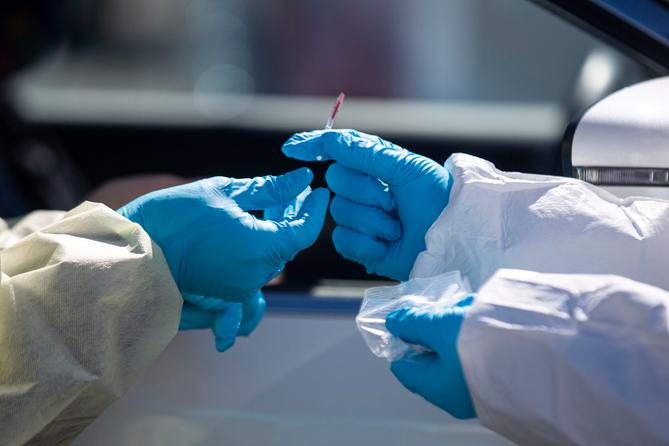Spotlight PA is an independent, nonpartisan newsroom powered by The Philadelphia Inquirer in partnership with the Pittsburgh Post-Gazette and PennLive/Patriot-News. Sign up for our free weekly newsletter.
Update, May 22: On Friday, a spokesperson for the Department of Health, Nate Wardle, told Spotlight PA and other media outlets he had given out erroneous information about the state’s inclusion of antibody tests in negative test totals. We have updated this story to reflect Wardle’s corrected statement.
HARRISBURG — Over the past week, Pennsylvania officials have reported a rising number of daily coronavirus tests, touting the increase as a sign the state’s capacity is improving — a necessary step to prevent outbreaks as more people emerge from their homes and go back into their communities.
“We are working right now to ramp up and increase our testing. In fact, today, we are reporting that we have done more than 11,000 tests that were reported yesterday,” Health Secretary Rachel Levine said earlier this week. “And that’s the highest that we’ve had.”
But experts say the data may present a distorted picture of the on-the-ground reality. Pennsylvania is including in its official count not only viral tests that reveal who currently has COVID-19, but also antibody tests that show whether a person was previously infected and has since recovered.
That means the public could have a skewed real-time understanding of just how prevalent COVID-19 is in their community — key information needed to safely reopen businesses and end stay-at-home lockdowns.
A viral test checks for a current infection (think long swabs up someone’s nose) while an antibody test uses blood to check for proteins that indicate a previous infection, even if a person did not show symptoms.
Levine first said the state was reporting antibody tests but not separating the results on May 11, which prompted Spotlight PA to look into the subject.
“The antibody test is essentially a rearview mirror — the footprints in the sand about people who’ve already been affected," said Dr. Tom Tsai, a surgeon and health policy researcher with the Harvard University School of Public Health.
Antibody tests are important tools used to identify previously unknown cases, but they can’t show who’s currently sick and contagious. Communities need that information to deploy crucial resources and respond to emerging outbreaks.
“The implications and the following actions are very different based on these two test results,” Tsai said.
As of Thursday, the state reported 65,392 total positive cases of COVID-19. That number includes both cases confirmed with a viral test and those considered probable, defined by the Centers for Disease Control and Prevention as one that meets clinical criteria with no laboratory test or one that meets “presumptive laboratory evidence.”
The state is only counting some positive antibody tests as probable cases — those where the person was symptomatic and considered “high risk” for exposure, meaning they live or work with someone who tested positive, or in an area where there was an outbreak, according to Nate Wardle, a spokesperson for the Department of Health.
By being more selective, the state is attempting to control for the volatile rate at which antibody tests can produce a false positive. But Tsai said that poisons the process.
“When they’re applying this weird adjustment … then I have no idea how to adjust for that objectively because you sort of muddled it,” he said.
Positive antibody tests make up less than 1% of the coronavirus case count reported to the public, Wardle said, though that information is nowhere on the state’s website.
The state health department also does not publicly separate probable and confirmed cases, “because there has been a ton of confusion about probable cases,” Wardle said.
Dr. Esther Chernak, director of the Center for Public Health Readiness and Communication at Drexel University, said categorizing these cases as probable is the right thing to do, but that confirmed and probable cases should be reported separately. At the very least, the state should publicly say which percentage of cases are probable.
“If the number of probable cases increases … it will be important for the state to explain this," she said.
Perhaps more concerning to public health experts is the practice of lumping negative viral tests together with negative antibody tests.
Earlier this week, Wardle confirmed to Spotlight PA and several other media outlets that the state was reporting these negative results together. He could not say how many negative results — 303,514 total as of Thursday — were from antibody tests.
On Friday, after this story was published, Wardle backtracked and said he had “been informed our negative totals do not include antibody test results.”
Tsai said including negative antibody tests in the total “artificially decreases the test positive rate” — simply, how many tests come back positive for COVID-19 compared to those that show a negative result.
This metric demonstrates if enough people are being tested to capture the true rate of infection. The gold standard, according to experts, is 10% or less. Pennsylvania is currently at 17.7%, down from a high of roughly 20%.
The Department of Health also treats positive and negative antibody tests differently when dating them. A positive test is added to the date the patient said they first experienced symptoms, while a negative test is added to the date the laboratory reported the result.
“They are effectively backdating the numerator and inflating the denominator," Tsai said.
Pennsylvania is not the only state treating its data this way. The CDC and several states including Texas are also mixing the numbers from the two different tests, a practice that becomes even more problematic as states begin using metrics like the “test positive rate” to make reopening decisions.
According to Wardle of the state health department, Pennsylvania is not using probable cases, including those from antibody testing, to determine which areas can ease restrictions.
100% ESSENTIAL: Spotlight PA relies on funding from foundations and readers like you who are committed to accountability journalism that gets results. If you value this reporting, please give a gift today at spotlightpa.org/donate.

